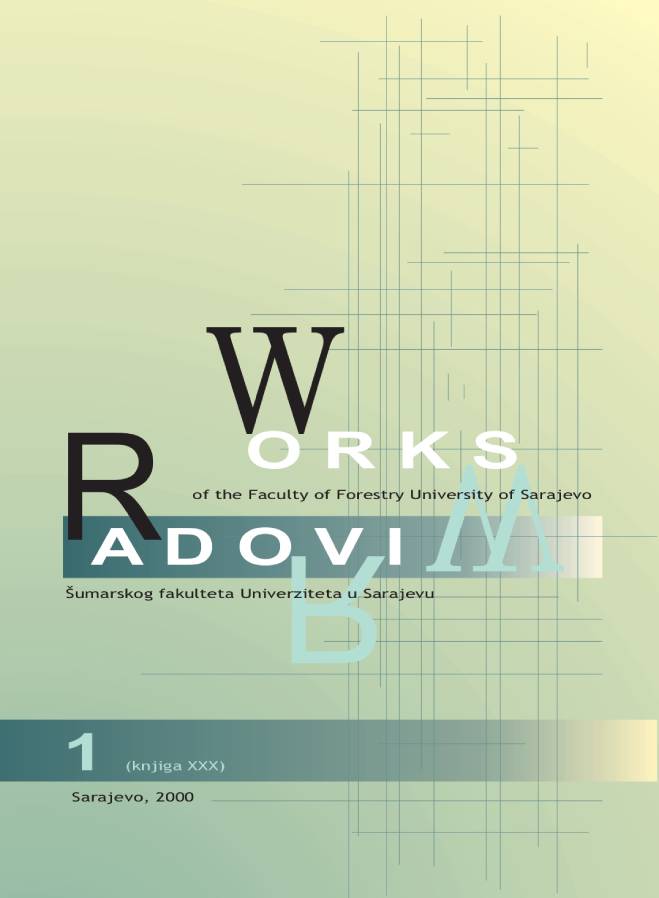MIKROPROPAGACIJA DIVLJE TREŠNJE (Prunus avium L.) U KULTURI IN VITRO
DOI:
https://doi.org/10.54652/rsf.2000.v30.i1.238Ključne riječi:
Prunus avium, wild cherry, regeneration, tissue culture, rootingSažetak
Vršni i pazušni pupoljci zrelih stabala divlje trešnje (Prunus avium L.) korišteni su kao biljni eksplanti za uspostavljanje kulture biljnog tkiva.Uzgajane su na bazalnoj MS podlozi sa dodatkom regulatora rasta. Indukcija pupoljaka je postignuta na MS mediju sa dodatkom 0,5 mg/1 BAP i 0,1 mg/1 IBA.
Gotovo 80% pupoljaka je uspješno otvoreno i regenerirano u izdanke.
Ista podloga je korištena za umnožavanje izdanaka, a njihov broj je utrostručen nakon trećeg ciklusa umnožavanja.
Za ukorjenjivanje odabrani izdanci stavljeni su na bazalnu MS podlogu sa dodatkom 126 mg/1 PG i 3 mg/1 IBA.
Faza ukorjenjivanja bila je 20% uspješna.
Najbolji rezultati u regeneraciji iz eksplantata lista postignuti su na DCR mediju sa dodatkom 0,5 mg/1 BAP i 0,1 mg/1 NAA.
Downloads
References
Chalupa V. (1984): Vegetativno umnožavanje hrasta lužnjaka (Quercus robur L.), lipe (Tilia cordata L.) i (Sorbus aucuparia L.) u in vitro uvjetima. Lescnictvie, 30: 1019-1028.
Cornu D., Riffaud J.L., Capelli P. (1981): In vitro propagation of wild cherry tree (Prunus avium L.). Colloque IUFRO-Afocel, (Fontainebleau): 133-134.
Gautheret R.J. (1934): Culture du tissu cambial. C.r.Acad.Sci. 198: 2195-2196.
Gupta P.K., Durzan D.J. (1985): Shoot multiplication from mature trees of Douglas-fir (Pseudotsuga menziesii) and Sugar Pine (Pinus lambertiana). Plant Cell Reports 4: 177- 179.
Hammat N., Grant N.J. (1997): Shoot regeneration from leaves of Prunus serotina Ehrh. (black cherry) and Prunus avium L. (wild cherry). Plant Cell Report 17: 526-530.
Jelaska, S. (1994): Kultura biljnih stanica i tkiva. Školska knjiga, Zagreb.
Kamenicka A., Rypak M. (1984): Možnosti indukcie organogenezy pagaštana kon sekeho (Aesculus hippocastanurn L.) in vitro. Biologia, 39: 531-536.
Međedović S. (1998): Regeneracija u kulturi zrelog embrija panciceve omorike- Picea omorika (Pancic) Purkinje. Radovi šumarskog fakulteta 1: 27-35.
Meier-Dinkel A. (1986): In vitro propagation of selected genotypes of mazzard (Prunus avium L.). Allgemeine-Forst-und-Jagdzeitung. 157: (7): 139-144.
Murashige T., Scoog F. (1962): A revised medium for rapid growth and bioassays with tobaco cultures. Psyosiol Plant 15: 473-499.
Ochatt S.J. (1991): Strategies for plant regeneration from mesophyll Protoplasts of the recalcitrant and farmwoodland species Prunus avium L. (sweet / wild chery), Rosaceae. J.Plant.Physiol. 139: 155-160.
Riffaud, J.L. (1980): Vegetative propagation of wild cherry (Prunus avium L.). Document-Centre-de-Recherches-Forestieres-d'Orleans: 80/1.
Rogatis A.D., Fabbri F. (1998): Improved regeneration of wild cherry (Prunus avium L.). In press.
Šilić, Č. (1973): Atlas drveća i grmlja. Svjetlost, Sarajevo.
Tricoli D.M., Maynard C. A., Drew A.P. (1985): Tissue culture of propagation of mature trees of Prunus serotina Ehrh. I. Establishment, multiplication, and root ing in vitro. Forest-Science 31: (1): 201-208.
Vietez A. M., Vietez M. L. (1980): Culture of chestnut shoots from buds in vitro. .J. Hort. Sci., 55: 83-84.
White Ph.R. (1934): Potentially unlimited growth of excised root tips in a liquid medium. Plant Physiol. 9: 585-600.
Zanetto A. (1996): The European Prunus Database (EPDB)-Status of database. Report of Working Group on Prunus 1: 4-8.






















